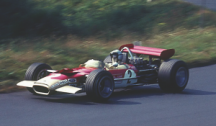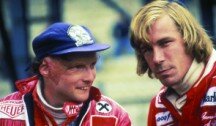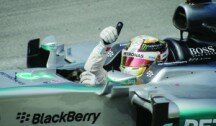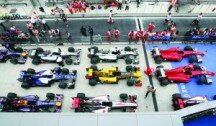Take a supercharged trip down memory lane and see how the cars and the larger-than-life characters of F1 have changed over the years
1930s – 1950s
The roots of Formula 1 can be traced back to the early days of motor racing, emerging from the growing European racing scene in the inter-war years. Original plans for the Formula 1 championships were discussed in the 1930s but put on hold due to the outset
of World War Two.
Talks resumed after the war and it wasn’t until May 1950 that the first world championship race was held at Silverstone, England while the first F1 race had taken place a month earlier in Pau, France. Only seven of the races that year counted towards the championship but the competition was up and running, established as an annual sporting event.
The sport got off to a bumpy start and in 1952 and 1953, due to a lack of entrants, the authorities ran the races under Formula 2 regulations – with Ferrari’s Alberto Ascari winning back-to-back championships.
1950s – 1970s
In the beginning, the sport was dominated by major pre-war manufacturers like Alfa Romeo, Ferrari, Maserati and Mercedes. Of the 20 manufacturers that initially competed in the early days many were forced out due to high running costs. The driver death toll was also a major concern as the first decade of the championships saw 13 drivers killed in various incidents.
The first seasons were run using pre-war cars like Alfa’s 158, front-engined, with narrow-treaded tyres and 1.5 litre supercharged or 4.5 litre aspirated engines. When Formula 1 regulations returned in 1954 engines were then limited to 2.5 litres. Mercedes Benz made major improvements to its cars during this era until it withdrew from all motor sports in the aftermath of the 1955 disaster at Le Mans, which saw scores of spectators killed in a horrific crash. In the late 1950s Cooper introduced a rear-engined car and by 1961 all manufacturers ran similar models.
Mike Hawthorn’s championship win in 1958 ushered in an era of British dominance. Between Jim Clark, Jackie Stewart, John Surtees, Jack Brabham, Graham Hill and Denny Hulme, British and Commonwealth drivers won nine drivers’ championships. The British Racing Green Lotus, with its revolutionary aluminium-sheet monocoque chassis instead of the traditional space-frame design, was the dominant car.
1970s – 1990s
Cars became faster and slicker with Lotus innovating at the front with the introduction of ground-effect aerodynamics, providing enormous downforce, resulting in greatly increased cornering speeds.
The safety of drivers continued to be a concern as Lotus’ Jochen Rindt became the first and only driver to posthumously win a championship after being killed during a practice for the Italian Grand Prix in 1970. Sir Jackie Stewart, the three-time championship winner, also retired in 1973 following the death, during practice, of his close friend, and teammate, Francois Cevert.
Turbochargers, which first appeared in 1977, began to rule the roost. Nelson Piquet won his second title in 1983 with Brabham, and Niki Lauda’s half-point win in 1984 heralded the start of a dominant period for McLaren where they won the drivers’ title in seven out of eight years with Alain Prost and Ayrton Senna.
To combat the phenomenal power of cars, restrictions were brought in and turbochargers were banned in 1989. In the 1980s electronic driver aids began to emerge and by the early 1990s semi-automatic gearboxes and traction control were a natural progression.
The battle between the introduction of new technology and the accusation that
the drivers were becoming increasingly less relevant raged throughout the next
two decades.
1990s – present
McLaren and Williams dominated the 1990s. The rivalry between Prost and Senna ended in 1993 with Prost’s retirement and then in 1994 Senna died at Imola. His death was a watershed moment for the sport leading to considerable increases in safety standards – no driver had since died right up until the tragic death of Jules Bianchi this year. The FIA introduced measures to slow the cars and improve their safety.
McLaren, Williams, Renault (formerly Benetton) and Ferrari won every World Championship from 1984 until 2008. The soaring costs widened the gap between the big four and independents between 1990 and 2008, 28 teams came and went, few making a notable impact.
Rising to prominence in the late 90s and early 2000s was Michael Schumacher and Ferrari, winning an unprecedented five consecutive drivers’ championships between 1999 and 2004. At the same time viewing figures dropped and concerns grew for the sport’s future given the difficulty for new entrants to make a lasting impression.
Championship rules were being frequently changed by the FIA (Fédération Internationale de l’Automobile) with the intention of improving the on-track action and cutting costs. In 2002 team orders, legal since the sports inception, were banned after several incidents in which teams openly manipulated race results. There was well documented tinkering over points scoring, pit stops, engines and tyres.
From 2000 some manufacturer-owned teams returned with success as Renault, BMW, Toyota, Honda and Ferrari became the main names of the championship, and through the Grand Prix Manufacturers Association (GPMA) negotiated a larger share of Formula 1’s
commercial profit and a greater say in the running of the sport.
The global expansion of Formula 1 continued with new races in lucrative markets in the Far and Middle East. Schumacher’s retirement in 2006 coincided with the sport again becoming more competitive on the track, but increasingly the headlines were dominated by behind-the-scenes politics as teams threaten to break away from F1 almost every year.
In recent years three drivers have been playing podium hopscotch – Fernando Alonso, Sebastian Vettel and Lewis Hamilton. They have each won multiple World Championships. However Kimi Räikkönen won the Championship in 2007 and Jenson Button took the top spot in 2009.
Since 2005 Renault has been one of the main manufacturers with Alonso’s back-to-back wins in 2005 and 2006 and providing engines for Red Bull in Vettel’s impressive four consecutive wins from 2010 to 2013.
Mercedes, who won in 2014 with Hamilton, have also enjoyed success also providing the engine for Button’s win in 2009 with Brawn.
Men of the machines
Jack Brabhan
Championship wins: Three, in 1959, 1960 and 1966
Most likely to: Found his own racing brand, Brabham
Key characteristics:
- Engineering expertise
- A man of few words
- Dirt-track driving style
James Hunt
Championship wins: One, 1976, the year of Niki Lauda’s accident
Most likely to: Throw-up before the beginning of a race
Key characteristics:
- A need for speed
- Big personality on and off the track
Ayrton Senna
Championship wins: Three, in 1988, 1990 and 1991
Most likely to: Push other drivers to their limit on the track
Key characteristics:
- Unwavering dedication to the sport
- Blistering pace
- Incredible intuition and control
Michael Schumacher
Championship wins: Seven, his last in 2004
Most likely to: Bend the rules to try and win
Key characteristics:
- Clinical and efficient driving
- Consistency
- Dubious sporting integrity
Lewis Hamilton
Championship wins: Three, most recently this year
Most likely to: Date a popstar
Key characteristics:
- Outrageous speed
- Flamboyant fashion sense
- Selfie addict
















 UPDATE: Be part of the action at Abu Dhabi HSBC Golf Championship
UPDATE: Be part of the action at Abu Dhabi HSBC Golf Championship UPDATE: A sweet initiative to bring a smile this festive season
UPDATE: A sweet initiative to bring a smile this festive season UPDATE: Capital awards focuses on sports journalists
UPDATE: Capital awards focuses on sports journalists Ancient fort stands tall for 2016 festival
Ancient fort stands tall for 2016 festival Abu Dhabi cruise terminal launches
Abu Dhabi cruise terminal launches Tickets to New Year concerts
Tickets to New Year concerts New Year’s Day brunch for two
New Year’s Day brunch for two A hot stone massage
A hot stone massage A gift bag from Herbal Essentials
A gift bag from Herbal Essentials New Year’s Eve package for two
New Year’s Eve package for two The key to tri training
The key to tri training The hard knock life
The hard knock life Drive the desert in style
Drive the desert in style Future aces
Future aces Thrills and spills
Thrills and spills Creative family thinking about the bigger picture
Creative family thinking about the bigger picture Abu Dhabi Diary: Things to do this week
Abu Dhabi Diary: Things to do this week Good health is child's play
Good health is child's play Where to find that festive feeling in Abu Dhabi...
Where to find that festive feeling in Abu Dhabi... New campaign shows breast is best
New campaign shows breast is best Telling tales
Telling tales New kid on the block
New kid on the block Flex appeal
Flex appeal A journey set in melodies
A journey set in melodies Caravan: Journey of Art at The Space
Caravan: Journey of Art at The Space National Day @ Odyssey Nursery
National Day @ Odyssey Nursery Holiday celebrations with Power Play tennis
Holiday celebrations with Power Play tennis Health facility opens in Al Shamkha
Health facility opens in Al Shamkha Over to You
Over to You Evolution of man and machine
Evolution of man and machine Racetrack rivalries
Racetrack rivalries Racing through the 2015 season
Racing through the 2015 season Going Trackside - Everything you need to know
Going Trackside - Everything you need to know The A-Z of Formula 1
The A-Z of Formula 1












